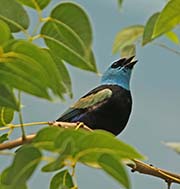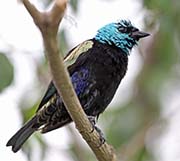Blue-necked Tanager - Tangara cyanicollis
| Length | |
| Weight | |
| Clutch Size | |
| Chicks at birth | |
| IUCN Conservation Status | |
Continents: |
The Blue-necked Tanager is found in northern South America. The range is large but disjoint and the local subspecies have developed color differences in their plumage. The head is bright blue or violet and the eyes and bill are black. The back and underparts are black except for its rump which varies by subspecies. The rump can be silvery green, yellow, or blue. Wings are multi-colored and vary from turquoise to a light brown. The juveniles are brownish gray, with a hint of adult coloration.
I noticed that you can purchase this bird on-line. At the one site I looked at, it was at the top of the price range ($250).
Diet: Blue-necked Tanagers eat fruits, berries, flower blossoms and insects. Tanagers will pick insects from leaves, or sometimes in flight, but fruit is the major dietary item.
Courtship: No information found.
Nesting: The female builds a cup nest of moss, usually well concealed, and lays an average of 2 white eggs with brown spotting. The male and female feed the nestlings on insects and fruit.
Habitat and Range: Blue-necked Tanagers are found in Bolivia, Brazil, Colombia, Ecuador, Peru, and Venezuela. The habitat is subtropical or tropical moist lowland forests, subtropical or tropical moist montanes, and heavily degraded former forest.
Vocalization: No Information found.
Plumage/Molt: Probably doesn't have an alternate plumage.
Migration: Not migratory.
Tongue/feet: The legs and feet are black.
Bibliography:
- http://en.wikipedia.org The Free Encyclopedia, Accessed June 2012
- http://birdlife.org BirdLife International, Accessed June 2012
- http://rosamondgifford.org/birds Rosamond Gifford Zoo, Accessed June 2012






